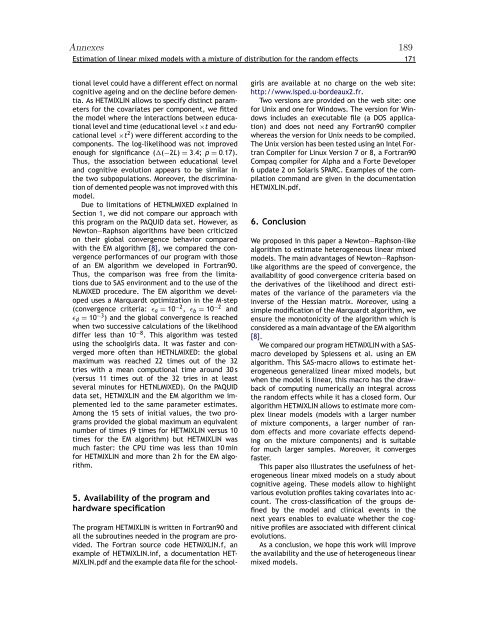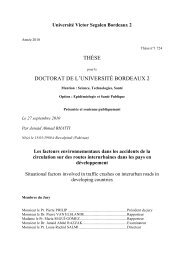Télécharger le texte intégral - ISPED-Enseignement à distance
Télécharger le texte intégral - ISPED-Enseignement à distance
Télécharger le texte intégral - ISPED-Enseignement à distance
- No tags were found...
Create successful ePaper yourself
Turn your PDF publications into a flip-book with our unique Google optimized e-Paper software.
Annexes 189Estimation of linear mixed models with a mixture of distribution for the random effects 171tional <strong>le</strong>vel could have a different effect on normalcognitive ageing and on the decline before dementia.As HETMIXLIN allows to specify distinct parametersfor the covariates per component, we fittedthe model where the interactions between educational<strong>le</strong>vel and time (educational <strong>le</strong>vel ×t and educational<strong>le</strong>vel ×t 2 ) were different according to thecomponents. The log-likelihood was not improvedenough for significance ((−2L) = 3.4; p = 0.17).Thus, the association between educational <strong>le</strong>veland cognitive evolution appears to be similar inthe two subpopulations. Moreover, the discriminationof demented peop<strong>le</strong> was not improved with thismodel.Due to limitations of HETNLMIXED explained inSection 1, we did not compare our approach withthis program on the PAQUID data set. However, asNewton—Raphson algorithms have been criticizedon their global convergence behavior comparedwith the EM algorithm [8], we compared the convergenceperformances of our program with thoseof an EM algorithm we developed in Fortran90.Thus, the comparison was free from the limitationsdue to SAS environment and to the use of theNLMIXED procedure. The EM algorithm we developeduses a Marquardt optimization in the M-step(convergence criteria: a = 10 −2 , b = 10 −2 and d = 10 −3 ) and the global convergence is reachedwhen two successive calculations of the likelihooddiffer <strong>le</strong>ss than 10 −8 . This algorithm was testedusing the schoolgirls data. It was faster and convergedmore often than HETNLMIXED: the globalmaximum was reached 22 times out of the 32tries with a mean computional time around 30 s(versus 11 times out of the 32 tries in at <strong>le</strong>astseveral minutes for HETNLMIXED). On the PAQUIDdata set, HETMIXLIN and the EM algorithm we imp<strong>le</strong>mented<strong>le</strong>d to the same parameter estimates.Among the 15 sets of initial values, the two programsprovided the global maximum an equiva<strong>le</strong>ntnumber of times (9 times for HETMIXLIN versus 10times for the EM algorithm) but HETMIXLIN wasmuch faster: the CPU time was <strong>le</strong>ss than 10 minfor HETMIXLIN and more than 2 h for the EM algorithm.5. Availability of the program andhardware specificationThe program HETMIXLIN is written in Fortran90 andall the subroutines needed in the program are provided.The Fortran source code HETMIXLIN.f, anexamp<strong>le</strong> of HETMIXLIN.inf, a documentation HET-MIXLIN.pdf and the examp<strong>le</strong> data fi<strong>le</strong> for the schoolgirlsare availab<strong>le</strong> at no charge on the web site:http://www.isped.u-bordeaux2.fr.Two versions are provided on the web site: onefor Unix and one for Windows. The version for Windowsincludes an executab<strong>le</strong> fi<strong>le</strong> (a DOS application)and does not need any Fortran90 compi<strong>le</strong>rwhereas the version for Unix needs to be compi<strong>le</strong>d.The Unix version has been tested using an Intel FortranCompi<strong>le</strong>r for Linux Version 7 or 8, a Fortran90Compaq compi<strong>le</strong>r for Alpha and a Forte Developer6 update 2 on Solaris SPARC. Examp<strong>le</strong>s of the compilationcommand are given in the documentationHETMIXLIN.pdf.6. ConclusionWe proposed in this paper a Newton—Raphson-likealgorithm to estimate heterogeneous linear mixedmodels. The main advantages of Newton—Raphsonlikealgorithms are the speed of convergence, theavailability of good convergence criteria based onthe derivatives of the likelihood and direct estimatesof the variance of the parameters via theinverse of the Hessian matrix. Moreover, using asimp<strong>le</strong> modification of the Marquardt algorithm, weensure the monotonicity of the algorithm which isconsidered as a main advantage of the EM algorithm[8].We compared our program HETMIXLIN with a SASmacrodeveloped by Spiessens et al. using an EMalgorithm. This SAS-macro allows to estimate heterogeneousgeneralized linear mixed models, butwhen the model is linear, this macro has the drawbackof computing numerically an integral acrossthe random effects whi<strong>le</strong> it has a closed form. Ouralgorithm HETMIXLIN allows to estimate more comp<strong>le</strong>xlinear models (models with a larger numberof mixture components, a larger number of randomeffects and more covariate effects dependingon the mixture components) and is suitab<strong>le</strong>for much larger samp<strong>le</strong>s. Moreover, it convergesfaster.This paper also illustrates the usefulness of heterogeneouslinear mixed models on a study aboutcognitive ageing. These models allow to highlightvarious evolution profi<strong>le</strong>s taking covariates into account.The cross-classification of the groups definedby the model and clinical events in thenext years enab<strong>le</strong>s to evaluate whether the cognitiveprofi<strong>le</strong>s are associated with different clinica<strong>le</strong>volutions.As a conclusion, we hope this work will improvethe availability and the use of heterogeneous linearmixed models.
















